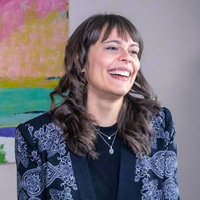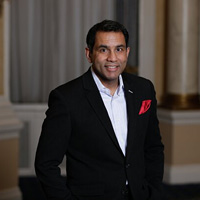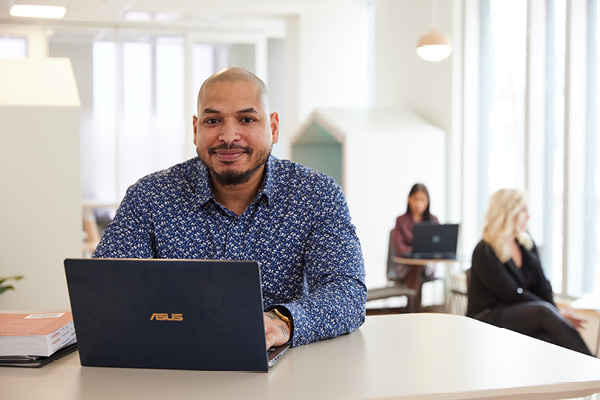At SAIT, we work with industry partners to design programs that prepare you for in-demand careers. This ensures you hit the ground running when you start working. Whether you’re looking for a fresh career start or to enhance your skills, SAIT will prepare you for what comes next.
What SAIT programming means for the industry and the tech sector is the attraction and retention of qualified product managers, a skill set that impacts not only the technology sector but all industries.
Renee Matsalla
Co-founder, Tacit Edge

This is an opportunity for hotel partners to help build a stream of future leaders — they’re going to need more than a general workforce, they’re going to need leaders.
Sol Zia
Executive Director, Calgary Hotel Association

SAIT graduates are a step ahead when it comes to project scheduling, preparing project plans, understanding stakeholder management and reading construction drawings, to name just a few areas.
Avree Bujaczek (B.Sc. CPM '15)
Project Coordinator, Calgary Municipal Land Corporation | Chair, CPM Program Advisory Committee

Work-integrated learning
Get hands-on experience through work-integrated learning opportunities informed by program advisory committees and industry-experienced instructors.
Are recognizable for SAIT credits and/or transcript recognition:
Activities that move ideas/concepts from the theoretical to the commercialization stage, usually by engaging in proof of concept, prototype development, testing and validation activities.
A program of training in a designated trade that offers formal instruction, in addition to on-the-job training, and is governed by a contract of apprenticeship that is registered under the Apprenticeship and Industry Training Act.
A capstone project brings together all the technical skills and hands-on experience students have acquired during their program. This practical and innovative project provides an opportunity for students to tackle an open-ended problem.
A clinical practicum is work-integrated learning that is integrated into the curriculum of an allied health program. The term “clinical” usually identifies learning experiences where students are directly and constantly supervised due to the nature of the activities and the risks and/or liabilities involved for the host organization, the post-secondary institution, students, clients, patients, and the general public.
Comprises the fourth year of study of an Applied Degree program. The student is typically paid for the work performed. The student receives a letter grade. This grade is included in the calculation of the student’s grade point average and is on the student’s transcript.
Structured work-term experience a year or less in duration, occurs after the student has completed at least one academic term of study, and is directly related to the student’s program of study. Students may or may not be paid. The student receives a letter grade. This grade is included in the calculation of the student’s grade point average and is on the student’s transcript. This term is often used interchangeably with “practicum”.
A practicum is a structured work-term experience a year or less in duration, occurs after the student has completed at least one academic term of study, and is directly related to the student’s program of study. Students may or may not be paid. The student receives a letter grade. This grade is included in the calculation of the student’s grade point average and appears on the student’s transcript. This term is often used interchangeably with “internship”.
A real (or imaginary) environment is simulated and users interact with and manipulate that environment (i.e. office, simulations in allied health programs, simulators used in the mobile crane program, etc.).
Have co-curricular recognition in most instances, but are not recognizable for SAIT credits and/or transcript recognition:
Delivers the most efficient range of support for high-growth tech and non-tech startups. Its services unite information resources, bootcamps, hackathons, industry coaching, high growth training and mentoring and access to markets and seed/follow on capital to help emerging entrepreneurs build scalable, investable businesses.
A program or situation that helps people become much better at doing something in a short period of time (i.e. computer programming bootcamp).
Also known as a hack day, hackfest or codefest, the hackathon is a design sprint-like event in which computer programmers and others involved in software development, including graphic designers, interface designers, project managers, and others, often including subject-matter-experts, collaborate intensively on computer programming.
An opportunity for a student to visit the workplace for observation, usually on a short-term basis (one or two days).
A project that involves the intentional creation, integration and/or transmission of knowledge with a view to informing professional practice, contributing to the state-of-practice within a field and/or impacting the broader external environment.
Activities that move ideas/concepts from the theoretical to the commercialization stage, usually by engaging in proof of concept, prototype development, testing and validation activities.
A pragmatic, progressive learning experiences that balance formal instruction and direction with the opportunity to serve in the community. To be successful, it must connect the traditional classroom experience with the real-life lessons that come through service learning.
In the business world, an incubator provides office space, equipment, and sometimes mentoring assistance and capital to new businesses that are just getting started.
Real-world work that students perform on the SAIT campuses (such as the Marketplace, downtown culinary campuses, SAIT’s radio station, working in power labs that actually help to power SAIT, working on vehicles for customers, etc.).
Students experience ‘real world’ challenges in competitive environments. It provides students with an overall richer educational experience; the training, collaboration and competition experience are all-important learning opportunities that prepare students for the workplace. Examples include business case competitions, concrete toboggan competitions, and Skills competitions at the provincial, national and international levels.
Want to learn more or get involved?
Hands-on classes = Hands-on careers
We're solving problems for the real world — learn why SAIT students and grads stand out and how they're making an impact with work-integrated learning.

Industry Mentorship Program builds confidence and inspires career paths
SAIT graduate Kori Ford (GIS ‘17) and current student Jorden Fanson share the benefits of their involvement in the Industry Mentorship Program. Get involved and benefit from mentoring or having a mentor.

SAIT launches Canada’s first remotely-piloted aviation training centre
The sky’s the limit! SAIT is home to Canada’s first remotely-piloted aviation training centre — an expansion within Applied Research and Innovation Services (ARIS) specifically focused on training, certification, research and development for Remotely-Piloted Aircraft Systems (RPAS).

The house that green tech built
A group of SAIT alumni and students helped bring this sustainable and international award-winning building to life through practicum and capstone opportunities. Through applying emerging green technologies, “The Confluence” could change the way we build homes.

Embedding students in industry
Hospitality and Tourism Management students specializing in Hotels and Accommodations check-in, figuratively speaking, for a 12-week practicum to connect with industry and apply their skills in a real-world setting.
100+ programs. 1000+ career options.
From capstone and co-op partners to practicum placements and career fairs — SAIT is proud to partner with 250+ industry leaders and companies.
Want to get involved as an employer or partner?

Oki, Âba wathtech, Danit'ada, Tawnshi, Hello.
SAIT is located on the traditional territories of the Niitsitapi (Blackfoot) and the people of Treaty 7 which includes the Siksika, the Piikani, the Kainai, the Tsuut’ina and the Îyârhe Nakoda of Bearspaw, Chiniki and Goodstoney.
We are situated in an area the Blackfoot tribes traditionally called Moh’kinsstis, where the Bow River meets the Elbow River. We now call it the city of Calgary, which is also home to the Métis Nation of Alberta.

